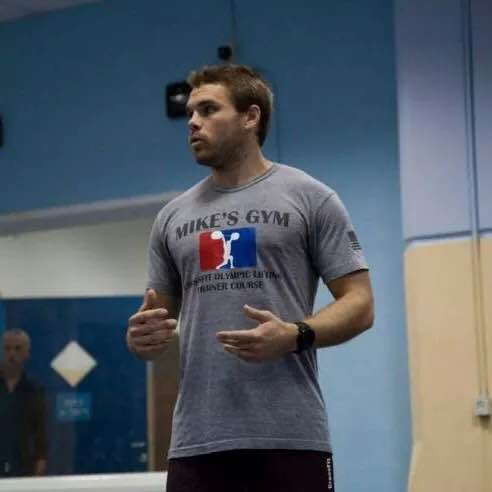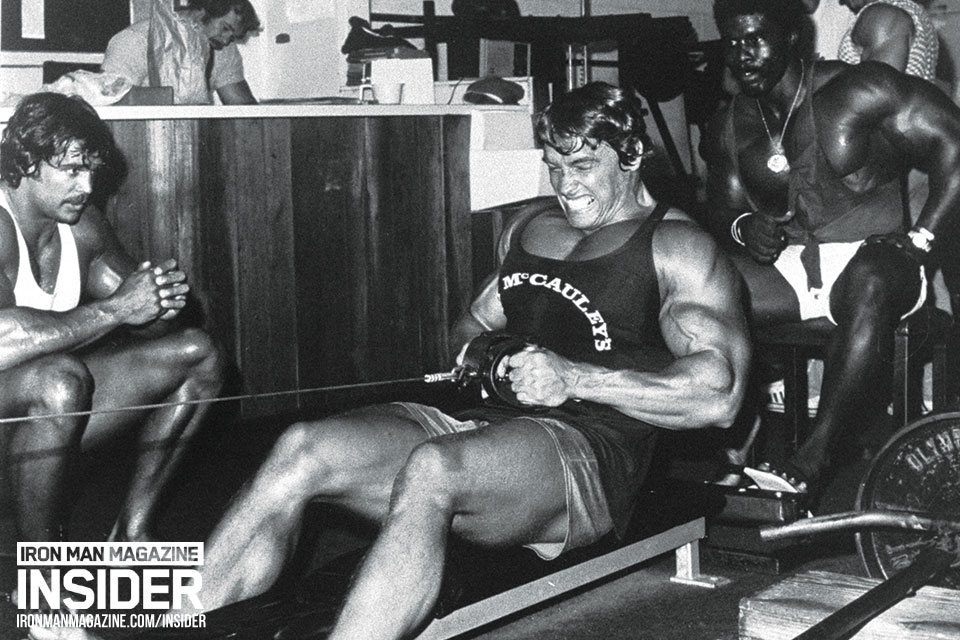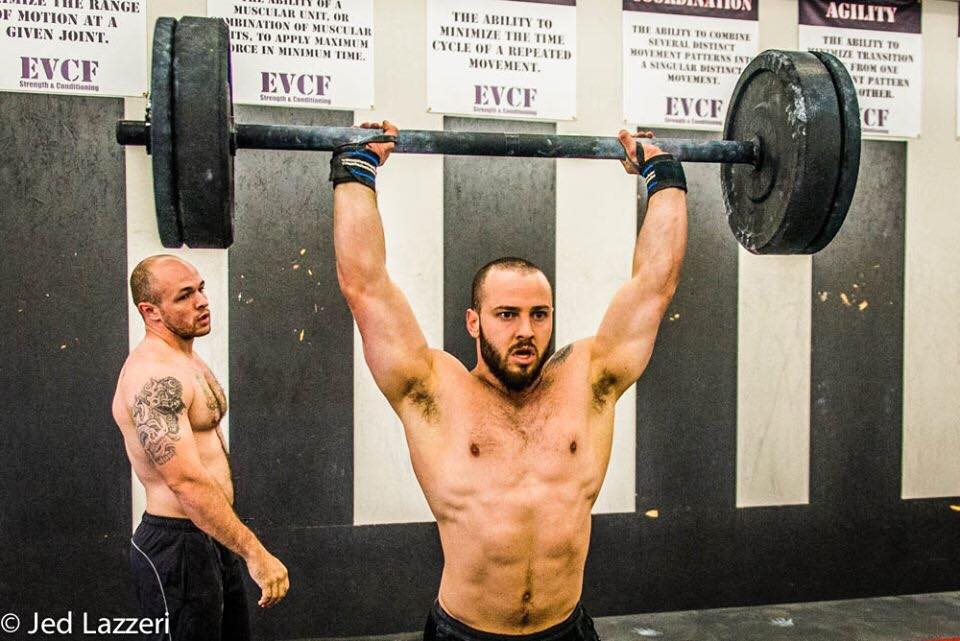The functional fitness movement was to some degree a backlash against the commercialization of fitness.…

Growing up Burgener: Interview with CrossFit Weightlifting Coach Beau Burgener
Your family name is so well-known in weightlifting circles that it’s basically synonymous with world-class coaching. I imagine that, growing up around weightlifting, you might have had a very different relationship with the sport than those of us that stumbled into it much later in life. Can you share a little bit about your beginnings in weightlifting? Did it always play a significant role in your life?
That you for the complement, and indeed, weightlifting has had a monumental role in my life. I start my course introductions by saying that I have 29 years of experience in the sport of Olympic weightlifting, and I’m 29 years old. By no means is it an exaggeration. When I was a young buck, my pops, Mike Burgener, was still competing in the Olympic lifts, as well as establishing himself as one of the top coaches in the sport. At the time, our two-car garage in Bonsall, California was a Regional training center for Team Southern California, and we had athletes that would come up to train M-Th evenings and Saturday mornings.
As a little kid, I wanted to be doing what Dad and the other older guys were doing, so inevitably, I picked up a barbell. Our weekend “outings” would be my pops loading up the kids and other lifters in the back of his ‘88 Dodge Ram and driving it around to different local meets. My fondest memories of these times are from competing at Muscle Beach in Venice Beach, CA at a young age (entered my first competition at 3 years old), and trying to win the $5 from Old man Hice.
Without a doubt, weightlifting has always played a significant role in my life. I’ve completed in the sport for 15 years, used the lifts to prepare myself for other sports and the military, and now I have a career that allows me to teach the Olympic lifts to thousands of people a year all around the world. It has, without a doubt, been the largest influence in my life.
When did you become a coach for the CrossFit Weightlifting Trainer seminars? Has that experience changed your approach to coaching at all?
Back in the ‘90s, my dad was teaching the USAW Weightlifting Club Coaches Course, so you could say my coaching career started by the time I was 10 years old. We got paid $20 to come in, demonstrate, and help out with the course. Our introduction to CrossFit occurred when Coach Glassman brought his crew to take the course, and a relationship developed between two great men. Around the 2005 time frame, Coach invited my pops to come up to Santa Cruz and teach the lifts Saturday mornings at the 3-day Level 1 courses that were held at CF Headquarters. I was going to university at the time in San Luis Obispo, so my dad would swing by, pick me up and we would head to Santa Cruz for the weekend. I went on to pursue other ventures the next few years, but circled back around to coaching the CrossFit Weightlifting courses in 2011.
Without a doubt, leading these courses has changed my approach to coaching. I was raised lifting around and hearing my dad coach advanced athletes. So, when I first started coaching the courses, I quickly discovered that I was a great coach when dealing with experienced lifters, but when it came to teaching someone who had never touched a barbell, I had A LOT to learn. This was a milestone in developing the coach I am now— leaving my ego at the door, having to take a step back, look at the lifts/sport from a different view and learn how to coach all over again. I’ll forever remember when I had this epiphany. I was teaching a push press to a beginner and asked her to dip, drive and press the barbell overhead. For the life of her, she couldn’t get this concept and I really had no other way to explain it, thought it was common sense. I was getting frustrated, but then took a deeper look into the circumstance and realized it wasn’t the athlete’s fault. It was my fault for not being able to break down and describe how to successfully perform the lift in a manner that she understood. A great coach has analogies and methods that will “hit home” and work for athletes of all levels.
What is the selection process for becoming a member of the CrossFit Weightlifting Seminar staff?
We follow a pretty simple selection process for coaches looking to get on our staff. When a coach shows interest, the first requirement is to perform three internships on our courses. Each internship will come with a little more responsibility and interns will be evaluated on how they are able to present our material to a group. After three internships, if we feel like they would be a good addition to the team, we bring them on board as a tier 2 coach. The selection process for the courses is as follows: family, location, seniority. The best advice I can give someone trying to become a coach in the CrossFit community is you MUST bring something to the table. We have hundreds of inquires coming in a year, so what is it that separates you from the crowd? My European coaching crew is extremely tight and a well-oiled machine. Each coach is unique and contributes positively to the course, which allows us to feed off each other and deliver the best weightlifting course in the world today.
I’m very curious about the philosophy behind these seminars. Attendees range from veteran weightlifting coaches to novice CrossFitters. How are these two days structured to maximize the benefit for all participants?
The goal of our course is to teach coaches how to teach the snatch, clean, and jerk safely, efficiently, and effectively. We teach the Burgener method. Is this the only way to teach the lifts? Absolutely not, but it is the method that we have found to be most efficient and beneficial not only for the athlete, but also for the coach. Our approach breaks the lifts down to the very basics so we can build from a solid foundation for the rest of the weekend.
Day 1 goes over the fundamentals of weightlifting: stance, grip, position, drills to enhance skills (Burgener warm up and skill transfer exercises), and finally snatching from different positions, 95% of which is done with a PVC pipe.
Once this foundation has been laid, we hit the ground running on day two! Sunday begins with a snatch breakout session, where athletes are allowed to take the weight up and are coached by the other members of their breakout group. The goal for this breakout is not only for the participants to start applying what they learned the day before, but also for the staff to see how the other participants coach. Do they understand what is happening during the lift and are they able to identify whether or not the necessary positions are being hit? Weightlifting is a sport of positions, so if someone to misses a position, it is important that the coach can identify the error, find root of it, and provide feedback on how to fix the problem. This, in essence, is developing your “coaching eye”. From here we can get a dialogue going, talk about what we saw and use the terminology and tools that were developed day 1 to get the lift squared away.
The rest of the day 2 is spent in similar breakout sessions, but we transition to the clean and jerk. The instruction for the clean is simple because the fundamentals have already been covered; the only difference is where an athlete grips and receives the barbell. Day 2 is structured in a manner that allows for a fast pace and a high volume of not only lifting, but also coaching. Whether you attend our course as an experienced lifter or a novice coach, I guarantee that you will walk away with tools to better yourself no matter what your goals are.
What are some of the most common mistakes/deficiencies you see at these seminars and how do you address them?
The number 1 mistake I see is athletes wanting to grip and rip the barbell off the ground, which puts them out of position right off the bat. With heavy weight, you must start in a good position in order to end in a good position. You must hit the “launch” position in order to give your body the best mechanical advantage for a powerful second pull, which is the bread and butter of the lifts! I address this issue by having athletes slow down their first pull, focus on the problem at hand, and if needed, I will have them pause at the launch position before completing the rest of the lift. The pause is a great tool because it builds muscle memory and allows the lifter to feel the position that he/she must be in.
The biggest deficiency I see in the course is athletes not having a usable bottom position, meaning they are not comfortable, flexible and/or strong in the bottom of an overhead squat or front squat. This can be due to lack of awareness, mobility and/or a mental roadblock. In my humble opinion, in order to get comfortable in a position, you must spend time in it! So I will have athletes sit in the bottom of every snatch for 3-5 seconds, perform pause front squats, and drill Sotts presses from front and back. You must get comfortable being uncomfortable! Obviously if it is mobility that is hindering their bottom positions, we can prescribe them mobility drills or possibly look at turning them into a splitter.
Do you have any favorite drills or skill transfer exercises for teaching the main lifts?
Without a doubt, it is the snatch balance—both with and without a dip. This drill will not only work foot and arm speed, but also build confidence in a lifter. It teaches the athlete how to move quickly under a large load. If you can snatch balance 110kg, when you go to attempt that 101kg PR snatch, you have the confidence knowing that if you can get the barbell overhead, the lift is yours! My prescription for this is have athletes work up the ladder performing a snatch balance, no dip (drop snatch) and once they fail (around 70-75%), continue climbing up in weight performing a snatch balance with a dip. It will allow you to see where you are in comparison to your best snatch, and identify weaknesses that need to be addressed.
Do you have any specific advice for CrossFit athletes who would like to transition to competitive weightlifting?
Find a coach and stick with a program. Having eyes on every lift of every session is crucial in your development as an athlete. If you can’t make it to a coach every session, then shoot for 1-3 times a week. Do what you can, with what you have, where you are. We had athletes driving 3+ hours to train with us on Saturday mornings down at Mike’s Gym. If you are serious about becoming a lifter, you will make sacrifices to train in an environment that offers you the best chance for success. Lastly, cut out the unnecessary metcons. This does not mean you can’t condition or CrossFit, but your conditioning sessions should aim to improve your lifting, not beat you down and fry your CNS. Incorporate hill/prowler sprints, heavy KB swings, high box jumps, etc. Train smarter.
Finally, what do we have to look forward to from you? Do you have any projects or specific objectives in your career that you’re working toward?
Currently, I’m leading the majority of the CrossFit weightlifting courses in UK, Europe, the Middle East, Australia and Asia. My goal is to provide the best weightlifting course out there in order to give the athletes and coaches an opportunity to improve themselves personally and professionally. Each course has a different dynamic due to the difference in cultures, but the one commonality across all regions is a passion for CrossFit and the Olympic lifts! As a crew, we are also focusing on having a more influential, modern approach to our website and social media. CrossFit Weightlifting wants to provide a location where people can view material in order to continue honing their coaching skills, as well as be part of the tightest weightlifting community in the world!
Where can people go to find you? (websites, social media, etc.)
FB: CrossFit Weightlifting Trainer Course
Email: [email protected]


